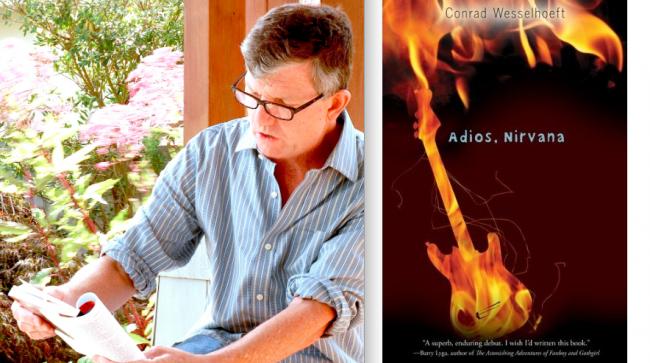New book 'Adios Nirvana' set in West Seattle
West Seattle author, Conrad Wesselhoeft, reads from his new book Adios, Nirvana, set in West Seattle. It is a work of fiction, but personal, real life tragedy influences the story's arc.
Thu, 09/09/2010
By Steve Shay
A new book, Adios, Nirvana, may interest many area readers, perhaps even those who generally prefer to “wait ‘til the movie comes out.” That’s because this book is about life, death, and coming of age in West Seattle. Many local references are made, including Easy Street Records, Schmitz Park, Admiral Way, Delridge Way, the West Seattle Bridge, area bus lines, and even Eddie Vedder. The book’s author, Conrad Wesselhoeft, 56, is a Fauntleroy resident. The book is officially scheduled to be released Oct. 25, but may be available sooner.
Published by Houghton Mifflin Harcourt, Adios, Nirvana is classified as “YA” (young adult) fiction, but may become a “crossover,” as the story promises to resonate with adults, too, particularly those with teens of their own.
The story is a “first-person confessional” by Jonathan, a gifted writer, darn good guitar player, and high school junior who wins a statewide poetry contest, beating out college entrants. He is close to self-destructing, due to a toxic cocktail of family dysfunction, teen angst, Red Bull, NoDoz tablets, insomnia, and the recent, unexpected death of his identical twin brother, Telemachus, or Telly. The promotional video trailer for the book states “Blood is thicker than water, and twin blood is thickest of all.”
He turns to Walt Whitman, Ernest Hemingway and Uncle Buk (Charles Bukowski) in the absence of his brother’s sagacious guidance. His literary gift often seems burdensome. Always toting pad and pen, the notes he spontaneously jots down on his take of the human condition serve to distract. But like those Red Bulls he guzzles, he can’t stop.
Jonathan: “If Stalin or Hitler arrested me and tossed me into one of those camps, I would carve words with my fingernails. If they cut off my fingers, I would write with my teeth. If they pulled out my teeth, I would blink my words to any listening bird. If they cut off my eyelids, I would fart code into the troposphere. You’d have to kill me to stop me from writing. That’s how I breathe.”
Jonathan’s “thicks,” or clique of friends, his stoic high school principal, his single, promiscuous mom, and others, root for his success while they try to slap some sense into the stubborn and haunted teen.
Wesselhoeft is a former New York Times editorial staffer, Cisco Systems senior editor, and World Vision senior writer. Some may remember him as the executive editor for the Community News Group, a Seattle Time Subsidiary that included the then Highline News, Federal Way News, and Des Moines News, in 1996-1997. He also spent two years in the Peace Corps teaching English in Western Samoa.
Wesselhoeft’s family tree intrigues. According to his bio, his great-great-great-grandfather Karl Wesselhoeft was the publisher, and close friend, of German literary icon Johann Wolfgang von Goethe, author of Faust. Two of Karl’s sons, Robert and William, worked on Goethe’s farm.
The boys immigrated to America and practiced homeopathy. Poet and physician, Oliver Wendell Holmes, Sr., publicly denounced Robert, a dispute that found its way into Nathaniel Hawthorne’s The Blithedale Romance. Conrad’s great-grandfather, George Lyman Kittredge, taught Shakespeare at Harvard to students Franklin Roosevelt, Thomas Wolfe, and William S. Burroughs.
Ask Wesselhoeft if Adios, Nirvana is at all autobiographical and he will say yes, to a point, but will clarify with much pain involved. He has three kids, Claire, 20, a sophomore at UW, and a twin son and daughter, Kit (after Kittredge) and Jen, 16, juniors at Garfield High School. However, Kit and Jen were a bit younger than fictional twins Jonathan and Telly when he began writing the book, and of course both are alive and well.
However, in 2006, Conrad lost both his wife and father, and he draws on these tragedies, and Kit’s reaction to them, in his character development of Jonathan.
“The book sprang out of many things, including an overlayment of grief,” Wesselhoeft said. “The conventional idea of grief is sorrow and sadness and mourning and kind of a dark gray blanket over everything, and it’s not just that. It can also be laughter and joy and music and expressions of energy. You almost get to a survival mode. You do what you do to go on and go forward. In the case of my kids they responded through deepening friendships, joyous shared experiences, music, and goofiness.
“There would be a bunch of kids in the kitchen,” he said, referring to his twins and their friends just after the family tragedies. “I’d be working on the dishes, listening to this almost arrogant, irreverent humor. It seemed very natural. I was very grateful. My mind was widened to know you can respond to grief this way. A lot of that was getting into the texture of that time in our lives- ‘It’s really dark in here. Let’s let some light in.’
“The connection between Jonathan and Telly was extremely close,” he said. “When Telly died, Jonathan felt he died too. It’s not right to say Jonathan should be sad all the time.
“My son was pretty safe and functional. Jonathan was pretty extreme all the time.”
Conrad said that while Kit enjoys the attention the book’s video trailer brought him (Kit stars in it) and the notoriety the book may bring him, Conrad did not ask his son directly for input on the book.
“I did not vet my stuff through my son,” he said. “He’s read it. I haven’t heard his opinion yet. I hope he likes it.”


